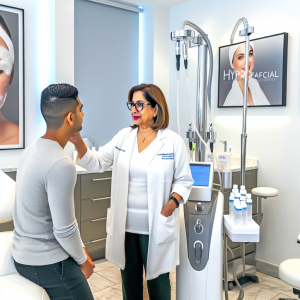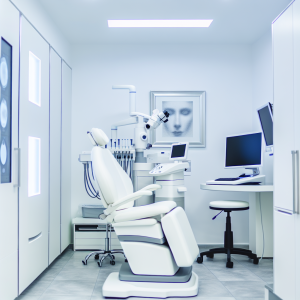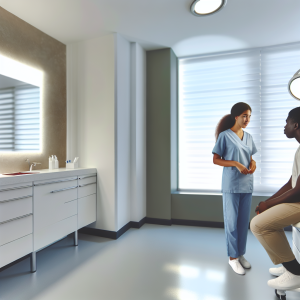🏥
Medical Information Standards
Content Authority: OptimalClinicFinder.com is a comprehensive medical directory platform connecting patients with qualified Acne Scar Treatment providers. Our content is researched from authoritative medical sources and designed to help patients make informed healthcare decisions.
How Fractional Laser Technology Works: Clinical Mechanism and Applications
Fractional laser treatment operates through controlled thermal injury that stimulates the skin’s natural healing cascade. The laser creates microscopic treatment zones that penetrate to precise depths, triggering collagen remodeling while preserving surrounding healthy tissue. This fractional approach allows for faster healing and reduced downtime compared to traditional ablative lasers while maintaining excellent clinical outcomes.
The treatment mechanism involves several key processes: immediate collagen contraction, inflammatory cascade activation, fibroblast stimulation, and organized collagen synthesis. Different laser wavelengths target specific chromophores and tissue depths, allowing customized treatment protocols. CO2 lasers (10,600nm) provide ablative resurfacing for severe scars, while erbium lasers (2,940nm) offer gentler ablation with faster healing. Non-ablative fractional lasers (1,550nm, 1,927nm) stimulate deeper remodeling with minimal surface disruption.
💡
Did You Know?
Clinical studies show that Acne Scar Treatment patients achieve excellent results when combined with professional-grade aftercare products.
Clinical Research and Evidence Base
Extensive clinical research supports fractional laser efficacy for surgical scar treatment. Landmark studies including multi-center randomized controlled trials have demonstrated 60-90% improvement in scar appearance across various scar types. The ASDS Consensus Statement on Laser Scar Treatment synthesized data from over 200 published studies, establishing evidence-based treatment protocols.
Recent meta-analyses confirm superior outcomes with fractional lasers compared to traditional treatments. Studies show particular efficacy for hypertrophic scars, keloids, and atrophic surgical scars. Long-term follow-up data spanning 5+ years demonstrates durability of improvements, with patient satisfaction rates exceeding 85%. Comparative studies reveal fractional lasers outperform microneedling, chemical peels, and topical treatments for moderate to severe surgical scars.
Laser Treatment for Surgical Scars: Treatment Protocols and Clinical Management
Successful laser scar treatment requires comprehensive patient evaluation and individualized protocol development. Initial assessment includes scar classification using validated scales (Vancouver Scar Scale, Patient and Observer Scar Assessment Scale), skin type determination, and medical history review. Treatment planning considers scar age, size, location, and patient goals to optimize outcomes.
Standard treatment protocols typically involve 3-6 sessions spaced 4-8 weeks apart, allowing adequate healing between treatments. Treatment parameters are adjusted based on scar response, with gradual intensity increases for optimal remodeling. Pre-treatment preparation includes sun avoidance, discontinuation of photosensitizing medications, and prophylactic antiviral therapy when indicated. Post-treatment care involves proper wound care, sun protection, and scheduled follow-up assessments.
💡
Quick Tip
Acne Scar Treatment works best when combined with healthy lifestyle choices for optimal results.
Safety Profile and Adverse Event Management
Fractional laser treatment demonstrates an excellent safety profile when performed by qualified practitioners. Common temporary side effects include erythema (redness), edema (swelling), and mild discomfort lasting 3-7 days. Most patients experience minimal downtime with proper protocol selection and post-treatment care.
Serious adverse events are rare, occurring in less than 2% of treatments. These may include prolonged erythema, hyperpigmentation, hypopigmentation, or scarring. Risk factors include darker skin types, recent sun exposure, active infections, and certain medications. Proper patient selection, appropriate laser parameters, and experienced practitioners minimize complication risks. Clear protocols for adverse event management ensure optimal patient safety and outcomes.
Cost Analysis Access Considerations
Laser scar treatment costs vary significantly based on geographic location, provider expertise, facility type, and treatment complexity. Per-session costs typically range from $300-800, with most patients requiring 3-6 sessions for optimal results. Total treatment costs usually range from $1,500-4,000, representing significant value compared to surgical revision procedures.
⚠️
Safety First
Always consult a qualified medical professional before starting Acne Scar Treatment. Results vary by individual.
Insurance coverage for cosmetic scar treatment varies by provider and policy terms. Some plans cover treatment for functional impairment or when scars cause physical symptoms. Medical financing options, practice payment plans, and seasonal promotions can make treatment more accessible. Many practices offer package pricing for multiple sessions, reducing overall treatment costs for patients.
Provider Selection and Treatment Facility Evaluation
Selecting an experienced laser practitioner is crucial for optimal outcomes and safety. Patients should seek board-certified dermatologists or plastic surgeons with specific laser training and extensive scar treatment experience. Key qualifications include laser safety certification, continuing education participation, and demonstrated clinical outcomes through before/after photography portfolios.
✓
Why Choose Acne Scar Treatment?
●
Clinically proven
●
FDA approved
●
Minimal downtime
●
Long-lasting
Facility evaluation should include assessment of laser equipment quality, safety protocols, staff training, and accreditation status. Modern fractional laser systems from reputable manufacturers ensure optimal treatment parameters and safety features. The treatment environment should maintain strict sterility standards, emergency preparedness, and comprehensive patient education resources. Patient testimonials, online reviews, and consultation quality provide additional insight into provider expertise and patient satisfaction.
Advanced Treatment Considerations
Complex surgical scars may require combination therapy approaches for optimal outcomes. Advanced techniques include sequential laser treatments with different wavelengths, combination with radiofrequency devices, or integration with platelet-rich plasma therapy. Challenging scar locations, such as those over joints or in cosmetically sensitive areas, require specialized treatment modifications and extended follow-up care.
Emerging technologies continue to expand treatment options, including picosecond lasers, novel fractional platforms, and computer-guided treatment systems. These advances offer enhanced precision, reduced downtime, and improved outcomes for difficult-to-treat scars. Staying current with technological developments ensures access to the most effective treatment options available.
📚 Medical Authorities & Professional Standards
All Acne Scar Treatment procedures should be performed by licensed medical professionals following established clinical guidelines and safety protocols.
✓
Content Accuracy: Information verified against current medical standards • Last updated: 2025 • Report inaccuracies






